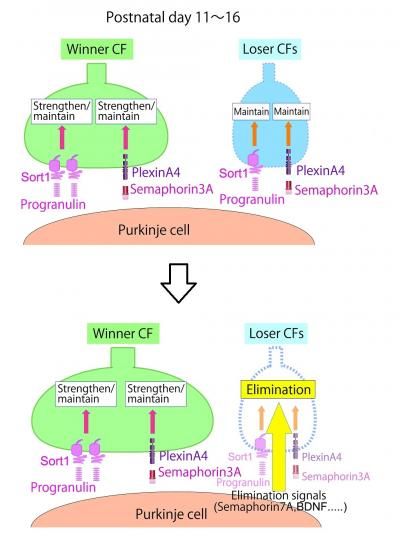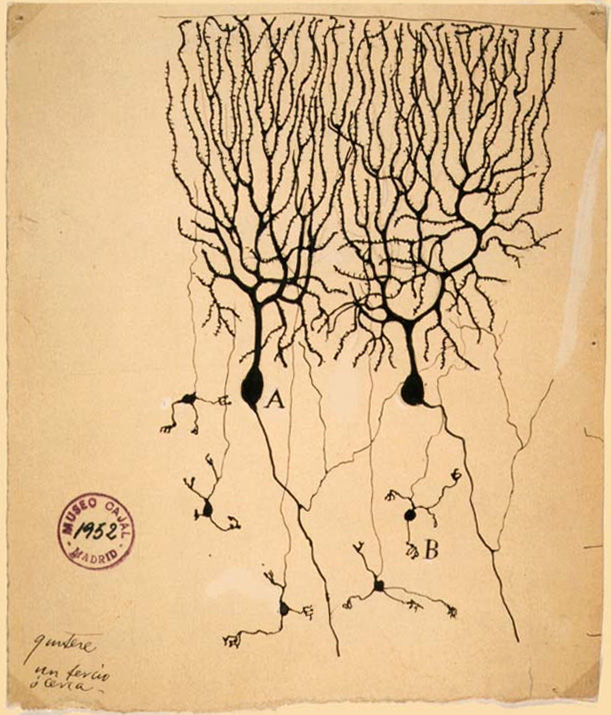Neuroscience
Molecule in Cerebellum Spurs Brain Cell Winners and Losers
Progranulin from Purkinje cells counteracts pruning process in the cerebellum.
Posted February 4, 2018

For the first time, scientists from the University of Tokyo have identified that a molecule derived from Purkinje cells in the cerebellum called “progranulin” reinforces the strongest ("winner") climbing fiber and counteracts the elimination of synapses that normally occurs in the brain after birth. Although this study was conducted on mice, the researchers speculate that progranulin dysfunction may result in the atypical “pruning” of nerve fibers and connections that underpin various neurological disorders in humans, ranging from autism to frontotemporal dementia. The findings were published on February 1, 2018, in the journal Neuron.
During typical early development, each Purkinje cell is connected to multiple climbing fibers. As the healthy cerebellum matures, synaptic inputs are typically eliminated, until there’s only one climbing fiber input per Purkinje cell. Both the elimination of redundant synapses and the fortification of important synapses are key to optimizing our neural circuitry in both life and sport.
Unfortunately, certain genetic mutations and environmental factors can disrupt the pruning and plasticity of Purkinje cells, which can result in way too many synaptic connections, or not nearly enough. Being on either end of these extremes can result in a myriad of neurological and neuropsychiatric disorders.
If the typical neural pruning process is disrupted — and cerebellar functions don't become streamlined — Purkinje cells can easily short-circuit from too much background noise and information overload. This helps to explain why Purkinje cell dysfunction is at the root of many symptoms observed in autism spectrum disorder. (For more, see "Autism, Purkinje Cells, and the Cerebellum Are Intertwined.")
Ideally, each climbing fiber provides robust, excitatory input to the cerebellum, which triggers a powerful excitatory postsynaptic potential (EPSP) spike in its corresponding Purkinje cell. This dynamic makes the partnership of climbing fibers and Purkinje cells central to fine-tuning and coordinating muscle movements used in everyday activities, while playing a musical instrument, serving a tennis ball, etc.
In addition to coordinating motor skills, there is a growing body of evidence showing that afferent climbing fiber systems play a key role in sensory processing and cognitive tasks that often function independently of conscious awareness. (For more, see “How Does the Brain Unconsciously Master Automatized Skills?”)
Using a cerebellum mouse model that was engineered without progranulin, Masanobu Kano and his Kano Laboratory team identified that climbing fibers were more quickly eliminated in the absence of this molecule (as seen in the diagrams above).
"Among multiple climbing fibers innervating each Purkinje cell in the neonatal cerebellum, a single climbing fiber is strengthened and maintained throughout an animal's life, whereas the other climbing fibers are weakened and eventually eliminated," Kano said in a statement. "Our goal was to identify a new molecule involved in strengthening and maintaining single climbing fiber inputs."
The underlying principle of neuroplasticity is based on a “use it or lose it” type of "Neural Darwinism" that strengthens or weakens synaptic connections based on the purposefulness of each connection. Just like cultivating a Bonsai tree requires constant pruning to redirect nutrients to fortify certain branches, neural connections are pruned or nourished via complex molecular mechanisms that reinforce or counteract growth.

What Are the Origins of Neural Darwinism and the Concept of Neural Pruning?
One of the original pioneers of Neural Darwinism was Nobel Prize-winning researcher Gerald Edelman. In 1978, Edelman co-authored a seminal book, The Mindful Brain: Cortical Organization and the Group-selective Theory of Higher Brain Function (MIT Press) with Vernon B. Mountcastle of Johns Hopkins School of Medicine, whom many consider the "Father of Neuroscience."
The theory of "neuronal group selection" has three major components:
1. Developmental selection: Anatomical functional connectivity within the brain is a selective "mechanochemical" event that occurs at an epigenetic level during early development.
2. Experiential selection: Postnatal behavioral experiences strengthen or weaken synaptic connections between neuronal groups.
3. Reentry: Over time, varying degrees of amplification from a "neuronal chorus" facilitate spatiotemporal accuracy in response to real-world interactions.
"Chinese Fan" Appearance of Purkinje Cells Makes Them Highly Distinctive
Purkinje cells (which are the largest and most distinctive neurons in the human brain) are named after Johannes Purkinje. He first identified these unique Chinese fan-shaped neurons and their fibers in 1837. Dr. Purkinje was also the first person to identify that every human being has unique fingerprints. He had a penchant for unmasking seemingly obvious things that everyone else tended to overlook.

Through the lens of sports and peak physical performance, it's important that athletes are cognizant of the pivotal role that Purkinje cells and the cerebellum play in mastering finely-tuned motor skills and implicit muscle memory.
Schmahmann's "Dysmetria of Thought" Hypothesis: A Cerebellar Game Changer
Historically, most experts believed that the cerebellum and Purkinje cells didn't play a role in nonmotor cerebral processes. That said, this outdated misperception of our "little brain" and Purkinje cells is rapidly evolving.
There is a growing amount of 21st-century evidence to support Jeremy Schmahmann's groundbreaking "Dysmetria of Thought" hypothesis (1998), which posits that specific regions of the cerebellum fine-tune and coordinate our thinking in much the same way that other regions of the cerebellum fine-tune and coordinate muscle movements.
Schmahmann is a professor of neurology at Harvard Medical School's Massachusetts General Hospital and a visionary thought leader on ataxia and the cerebellum. The motto of his MINDlink Foundation is "Connecting the cerebellum to cures."
"Schmahmann's Syndrome" (also known as "Cerebellar Cognitive Affective Syndrome" or CCAS) refers to deficits in the cognitive domains of executive function, spatial cognition, language, and behavior that stem from damage to the cerebellum.
The latest discovery on Purkinje cells, progranulin, and Neural Darwinism by Kano et al. is significant, because the researchers have pinpointed a specific molecule that can either reinforce or counteract climbing fiber "winners" and "losers" during the cerebellar pruning process.
"Our results provide a new insight into the roles of progranulin in the developing brain," Kano said. "We will continue to search molecules involved in synapse elimination in the developing cerebellum and, ultimately, we want to elucidate entire signaling cascades for synapse elimination."
Future research by Masanobu Kano and his team will focus on how to effectively manipulate the progranulin molecule. Although so much about the cerebellum and Purkinje cells remains a mystery, researchers from the Kano Lab are optimistic that someday interventions that influence progranulin signaling could help to treat a wide range of neurological and neuropsychiatric disorders.
References
Naofumi Uesaka, Manabu Abe, Kohtarou Konno, Maya Yamazaki, Kazuto Sakoori, Takaki Watanabe, Tzu-Huei Kao, Takayasu Mikuni, Masahiko Watanabe, Kenji Sakimura and Masanobu Kano. "Retrograde Signaling from Progranulin to Sort1 Counteracts Synapse Elimination in the Developing Cerebellum.” (Published: February 1, 2018) Neuron DOI: 10.1016/j.neuron.2018.01.018
Jeremy D. Schmahmann and Janet C. Sherman. "The Cerebellar Cognitive Affective Syndrome." Brain: A Journal of Neurology (1998) DOI: 10.1093/brain/121.4.561
Schmahmann, Jeremy D. "Dysmetria of Thought: Clinical Consequences of Cerebellar Dysfunction on Cognition and Affect." Trends in Cognitive Sciences (1998) DOI: 10.1016/S1364-6613(98)01218-2




